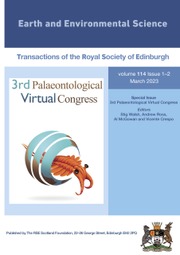Crossref Citations
This article has been cited by the following publications. This list is generated based on data provided by
Crossref.
Homann, Hermann
1933.
Die Milben in gesunden Bienenstöcken.
Zeitschrift für Parasitenkunde,
Vol. 6,
Issue. 3,
p.
350.
örösi-Pál, Z.
1934.
Bau, Entwicklung und Lebensweise des Bienenparasiten Acarapis Woodi (Acarina).
Zeitschrift für Parasitenkunde,
Vol. 7,
Issue. 2,
p.
233.
Royce, L. A.
and
Rossignol, P. A.
1990.
Honey bee mortality due to tracheal mite parasitism.
Parasitology,
Vol. 100,
Issue. 1,
p.
147.
1990.
List of contributions.
Parasitology,
Vol. 100,
Issue. S1,
p.
S3.
1991.
Reduction of tracheal mite parasitism of honey bees by swarming.
Philosophical Transactions of the Royal Society of London. Series B: Biological Sciences,
Vol. 331,
Issue. 1260,
p.
123.
Burgett, Michael
and
Kitprasert, Chutikarn
1992.
Tracheal Mite Infestation of Queen Honey Bees.
Journal of Apicultural Research,
Vol. 31,
Issue. 2,
p.
110.
Sugden, Evan A.
Williams, Kristina R.
and
Webster, Thomas C.
1995.
Attractiveness of CO2and Synthetic honey bee (Apis MelliferaL.) (Hymenoptera: Apidae) cuticular hydrocarbons to the honey bee tracheal mite,Acarapis woodi(Rennie) (Acari: Tarsonemidae).
International Journal of Acarology,
Vol. 21,
Issue. 4,
p.
283.
McMullan, John B.
and
Brown, Mark J. F.
2006.
Brood-cell size does not influence the susceptibility of honey bees (Apis mellifera) to infestation by tracheal mites (Acarapis woodi).
Experimental and Applied Acarology,
Vol. 39,
Issue. 3-4,
p.
273.
McMullan, John B.
and
Brown, Mark J.F.
2006.
The role of autogrooming in the differential susceptibility to tracheal mite (Acarapis woodi) infestation of honeybees (Apis mellifera) held at both normal and reduced temperatures during pupation.
Apidologie,
Vol. 37,
Issue. 4,
p.
471.
Oldroyd, Benjamin P
2007.
What's Killing American Honey Bees?.
PLoS Biology,
Vol. 5,
Issue. 6,
p.
e168.
MAEDA, Taro
2015.
Infestation of honey bees by tracheal mites, <i>Acarapis woodi</i>, in Japan.
Journal of the Acarological Society of Japan,
Vol. 24,
Issue. 1,
p.
9.
Chantawannakul, Panuwan
de Guzman, Lilia I.
Li, Jilian
and
Williams, Geoffrey R.
2016.
Parasites, pathogens, and pests of honeybees in Asia.
Apidologie,
Vol. 47,
Issue. 3,
p.
301.
MAEDA, Taro
2016.
Effects of tracheal mite infestation on Japanese honey bee, <i>Apis cerana japonica</i>.
Journal of the Acarological Society of Japan,
Vol. 25,
Issue. Supplement1,
p.
S109.
Sakamoto, Yoshiko
Maeda, Taro
Yoshiyama, Mikio
and
Pettis, Jeffery S.
2017.
Differential susceptibility to the tracheal mite Acarapis woodi between Apis cerana and Apis mellifera
.
Apidologie,
Vol. 48,
Issue. 2,
p.
150.
Amiri, Esmaeil
Strand, Micheline
Rueppell, Olav
and
Tarpy, David
2017.
Queen Quality and the Impact of Honey Bee Diseases on Queen Health: Potential for Interactions between Two Major Threats to Colony Health.
Insects,
Vol. 8,
Issue. 2,
p.
48.
Buendía, Maria
Martín-Hernández, Raquel
Ornosa, Concepción
Barrios, Laura
Bartolomé, Carolina
and
Higes, Mariano
2018.
Epidemiological study of honeybee pathogens in Europe: The results of Castilla-La Mancha (Spain).
Spanish Journal of Agricultural Research,
Vol. 16,
Issue. 2,
p.
e0502.
Yoshiyama, Mikio
and
Kimura, Kiyoshi
2018.
Asian Beekeeping in the 21st Century.
p.
223.
Sakamoto, Y.
Maeda, T.
Yoshiyama, M.
Konno, F.
and
Pettis, J. S.
2020.
Differential autogrooming response to the tracheal mite Acarapis woodi by the honey bees Apis cerana and Apis mellifera.
Insectes Sociaux,
Vol. 67,
Issue. 1,
p.
95.
Takashima, Shunsuke
Ohari, Yuma
and
Itagaki, Tadashi
2020.
The prevalence and molecular characterization of Acarapis woodi and Varroa destructor mites in honeybees in the Tohoku region of Japan.
Parasitology International,
Vol. 75,
Issue. ,
p.
102052.
Pattabhiramaiah, Mahesh
Mallikarjunaiah, Shanthala
and
Brueckner, Dorothea
2022.
Genetic Methods and Tools for Managing Crop Pests.
p.
89.

